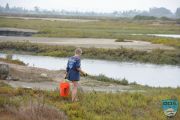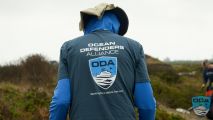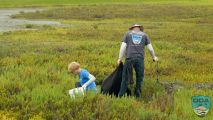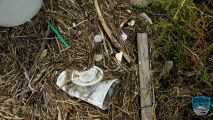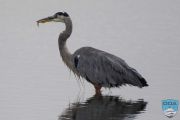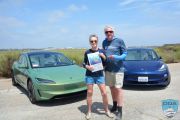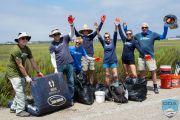By Founder and President Kurt Lieber
ODA is on a roll. After several months of heavy winter rains that kept us from our monthly cleanups at the Seal Beach National Wildlife Refuge (SBNWR), we hit our stride on Wednesday, August 7th.
This was our fourth month in a row of clawing out a huge amount of plastics from the dense vegetation that covers this nearly 2,000-acre wetland.
Each time we do a cleanup, I go into the refuge the day before and take a look around to find areas where I think we can have the most impact. It also gives me some time to pull out my camera and see if I can capture some images of the wildlife that thrive there.
After I located two sites worthy of our efforts, I found an area where some herons and egrets were hunting. At one point I saw a white heron poised to pounce on something with that knife like beak. When it caught something, whatever it was, started coiling itself around the beak!
Nearby, I saw a great blue heron doing the same thing. And in one of my images, I saw what those critters were. At least I thought I knew what it was… An eel? (You have to read to the end to find out!)
Early the Next Day
On Wednesday morning, our small but dedicated crew of volunteers met at the refuge headquarters, and then drove our cars to the first cleanup site.
Once everyone got their work gear on, we grabbed the buckets, trash pickers and headed out along the rim of one of the main ponds.
If you click on the first portrait below, you can scroll through our mini album of ODA Expert Wetland Cleaners!
The crew on this day were: Dennis Alp, Hannah Markel, Dave Merrill, Jean Merrill, Kent Morris, and Linda Nicholes. This was Dennis’ first time volunteering for ODA. Welcome aboard, Dennis!
Hannah was taking the photos, so she didn't get her own portrait like the others, so we're creating one here! And just so you know, she's not only a Super Marsh Cleaner and Videographer, she is a member of our ODA Social Media Team! She's amazing and we're grateful for her!
We were there at a pretty low tide, so it allowed us to get a little deeper into the grasses where a substantial number of degraded plastics are. A lot of the lighter materials, like disposable drink cups, just sit there and bake in the summer sun. Those cups are so thin that they can break into a hundred pieces when you try to pick them up. You can see this in action in our video below.
Hannah got some great video footage of that phenomenon in this short video she put together. Does she have talent or what?!?!
After about an hour at this first site we had pretty much gotten all the large objects, we posed for some pictures to document our haul of debris, and decided to move to another site, a short drive away. The staff who manage the wetlands come behind us and load the trash into pickup trucks to take it away for proper disposal.
Cleanup at Second Location
At this site, it was pretty much the same scenario, lots of plastics along the edge of the pond with slightly less in the grasses, but it all needs to come out. Because the tide was still low, we did our best to wade into the grassy area and remove what we could.
Dennis, Dave, and Kent found an old, old mattress that had been in there for what looked like years. It was heavy with water, and moldy. But the three of them picked it up and hauled it up the embankment to where we could load it into the haul away truck.
The day started out cloudy and by 11am or so the sun was out in full force. Glorious way to spend a day... with like-minded people giving up their time and energy to make this critical wetland healthier for all.
Here's our SECOND debris pile! We had to do another photo of the ODA Crew with the Catch of the Day!
When I got home and looked at my pictures, I still couldn’t tell exactly what that animal was that the herons were eating. So, I sent the pictures around to some people who might know. Cristina Robinson and Chloe Van Grootheest chimed in right away. That was a pipefish!
Pipefish thrive in healthy eel grass beds and are related to sea horses. Mystery solved, and 360 pounds of plastics are now headed to a landfill never to poison these wetlands again.
If you live in Southern California and would like to be a regular member of our SBNWR Cleanup Crew, please email us!

























